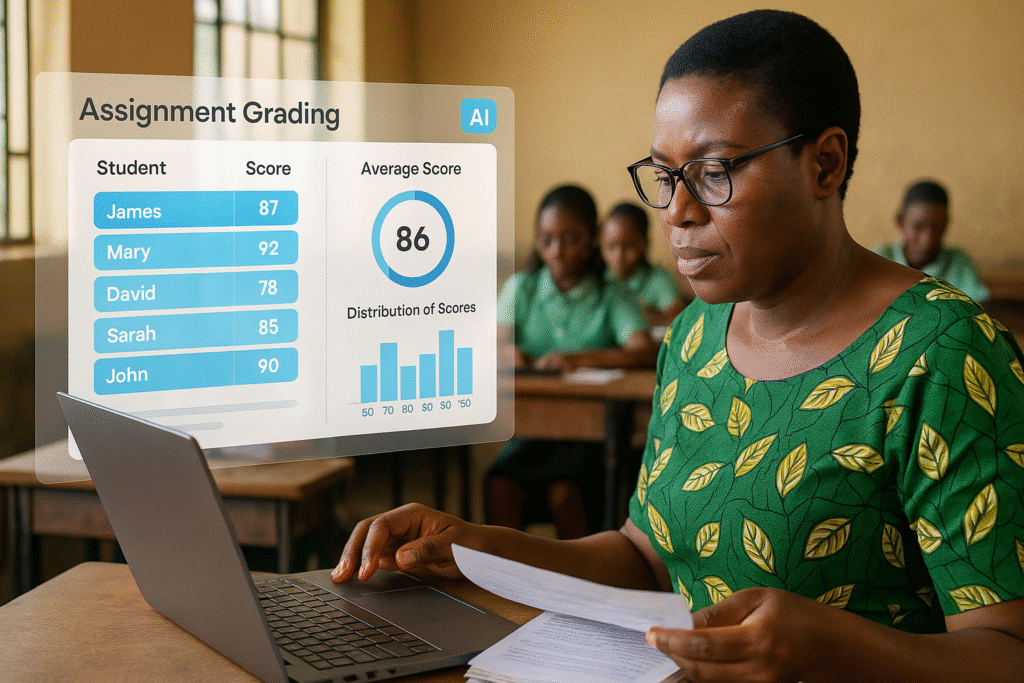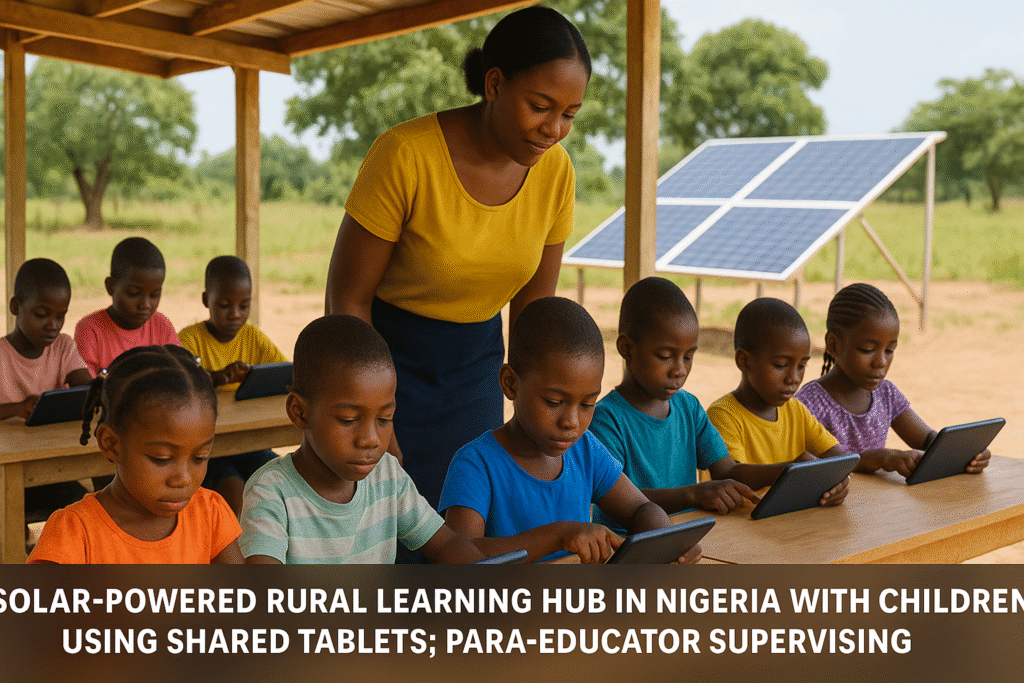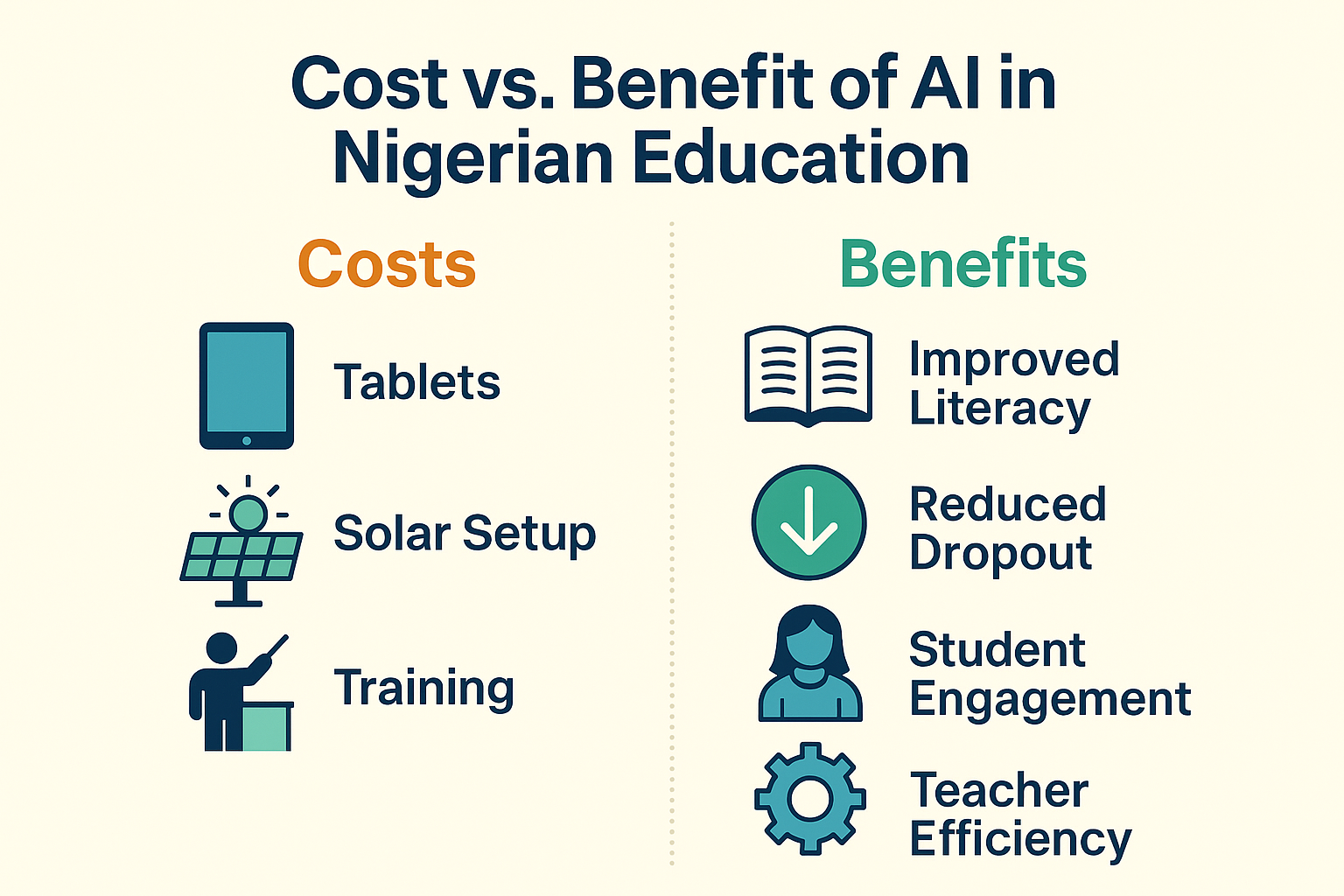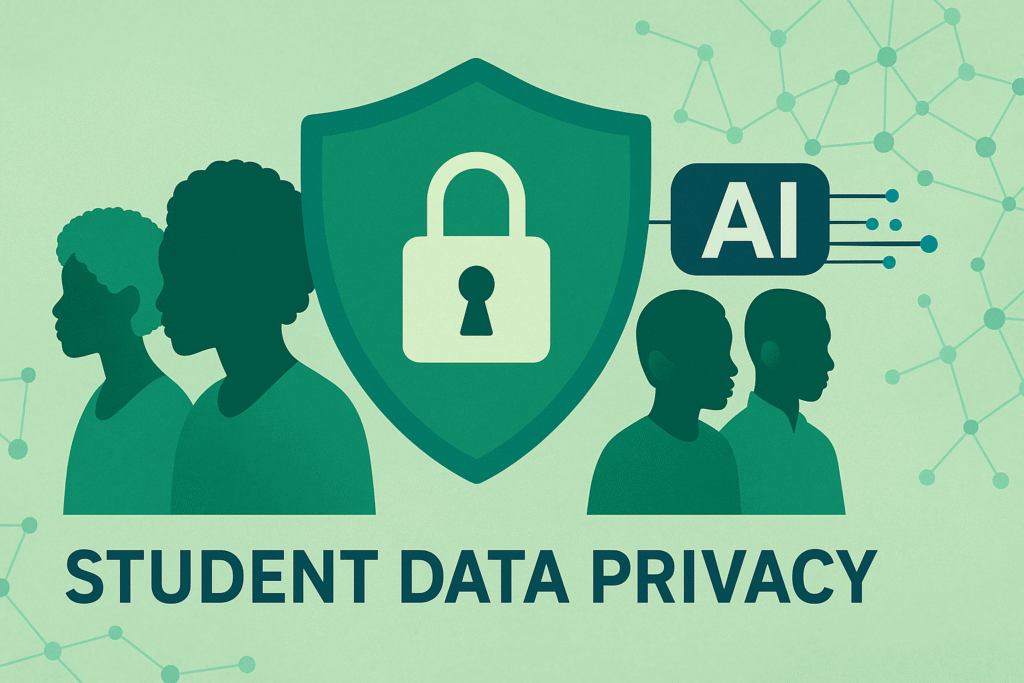Nigeria is at a crossroads in education. Despite decades of reform, the system continues to struggle with a crisis that undermines the future of millions of children.
International organisations, such as UNICEF, estimate that more than 10 million Nigerian children are out of school, one of the highest figures globally. Classrooms in rural areas are often overcrowded, underfunded, and lack trained teachers. Basic literacy and numeracy levels are low, particularly among girls and marginalised groups.
At the same time, Nigeria is home to a young, mobile-first population. Over 60% of its people are under 25, and mobile penetration exceeds 80% of households. This paradox—deep-seated systemic education gaps alongside the growth of digital connectivity—raises a central question: Can artificial intelligence (AI) help solve Nigeria’s education crisis?
This feature explores how AI could make a difference. It defines core terms simply, examines Nigeria’s challenges, reviews concrete AI applications, considers risks, and outlines implementation pathways.
Understanding Nigeria’s Education Crisis
Nigeria’s education challenges are multidimensional. There are access to education problems, quality issues, equity challenges, and capacity problems.

- Access – Millions of children, especially in northern states, remain out of school due to poverty, conflict, early marriage, or displacement. UNICEF notes that girls are disproportionately affected.
- Quality – Where schools exist, they often lack textbooks, up-to-date curricula, or trained teachers. Large class sizes—sometimes 50 or more students per teacher—are standard.
- Equity – Rural students and children from low-income households are less likely to complete their education. Gender gaps persist, with fewer girls completing secondary education.
- Capacity – Teacher training programs are underfunded. Digital literacy among teachers remains low. Infrastructure—such as electricity, internet, and safe classrooms—lags behind demand.
These factors combine to create poor outcomes.
The World Bank (2020) estimated that Nigeria’s “learning poverty” rate—referring to children unable to read a simple text by age 10—was over 70%. This crisis poses a threat to economic growth and social stability.
What Is AI, and Why Does It Matter for Education?
Artificial intelligence (AI) refers to computer systems that can perform tasks usually requiring human intelligence, such as understanding language, recognising speech, solving problems, or making decisions. In education, AI manifests in tools like:
Intelligent tutoring systems
Intelligent tutoring systems are AI-powered software programs that simulate one-on-one tutoring. They adapt to each student’s learning pace, strengths, and weaknesses, providing customised feedback and practice exercises. If a student is struggling with a concept, the system slows down or offers extra help. If a student is performing well, it advances them to more challenging material.
In crowded Nigerian classrooms where teachers cannot give each child individual attention, these systems could act as a quiet assistant, guiding one student through extra practice. In contrast, the teacher focuses on the group. The advantage is consistency and patience: the software never tires, and it delivers immediate feedback, allowing errors to be corrected on the spot.
Global pilots, such as Mindspark in India, have shown that adaptive tutoring tools can raise test scores among low-income students. For Nigeria, tailoring such systems to the national curriculum and major local languages could make them especially impactful.
Automated grading
Automated grading utilises AI to score tests and assignments, thereby reducing the time teachers spend on marking. The software handles multiple-choice questions easily but can also evaluate short written answers by detecting key ideas and standard errors.
In Nigeria, where teachers often face 50 or more students per class, this support could be transformative. It frees teachers to spend more time explaining lessons or mentoring students rather than working through piles of scripts.
A 2023 Ministry of Education pilot showed that AI-assisted grading cut marking time by nearly half while maintaining accuracy. The challenge is to ensure that these systems understand local exam formats and do not disadvantage students who write in non-standard English or regional dialects.
Automated grading is already being used for standardised exams like SATs, GRE, WAEC, NECO, JAMB, etc, which use optical mark recognition (OMR) and simple AI to grade tests quickly and accurately.
How AI Could Address Nigeria’s Core Education Challenges
Nigeria’s education problems are not abstract—they are visible every day in overcrowded classrooms, under-trained teachers, and children struggling to read or count at the right age.
AI does not solve these systemic issues on its own, but it can provide targeted support where the system is weakest. By focusing on access, teacher workload, language diversity, and personalisation, AI tools can complement traditional teaching and make scarce resources go further.
Expanding Access Through Mobile AI Tools
Nigeria’s high mobile penetration is a unique opportunity. Even in remote areas, many households own a basic smartphone. Lightweight AI tutoring apps could deliver lessons in math, reading, or science through SMS, WhatsApp, or low-data apps.
Example: In India, the AI-based app Mindspark improved math learning significantly among low-income students (Muralidharan et al., 2019). A Nigerian equivalent could adapt lessons to local curricula and languages.
Benefit: Out-of-school children could access structured learning from home or community centres.
Challenge: Data costs, device sharing in large households, and limited digital literacy of parents.
Supporting Teachers With Automated Grading and Lesson Planning

Nigeria’s average teacher-to-pupil ratio in primary schools is approximately 1:37, but is often higher in rural schools (UNESCO, 2022). Teachers spend a significant amount of their time marking assignments instead of teaching.
AI grading tools can quickly assess multiple-choice tests and even short essays. Platforms like Gradescope (used globally) show how machine learning reduces turnaround time. In Nigeria, a Ministry of Education pilot (2023) tested AI-assisted marking for secondary school exams, cutting grading time by 40%.
Impact: Teachers can redirect effort to interactive teaching, mentoring, and classroom management.
Reaching Students in Local Languages

Nigeria has over 500 languages. Many children struggle when instruction is only in English. AI-powered speech recognition and translation tools can help.
In 2022, the Northern Nigeria Educational Trust piloted a speech-recognition app that provided English pronunciation practice. Students improved their reading fluency within weeks. Expanding such tools to Yoruba, Hausa, Igbo, and Pidgin could increase comprehension and retention.
Personalised Learning for Large Classrooms
AI tutors adapt lessons to student performance. If a learner struggles with fractions, the system offers more practice. If they excel, it advances them.
In Lagos, a private edtech startup piloted an adaptive math tutor in 2024. Results showed measurable improvements in student test scores compared to control classrooms.
For government schools with large classes, such tools could supplement the limited time teachers have to devote to each student.
Chatbots for Parents and Students
Parents often lack information about school enrollment, exams, or scholarships. AI chatbots deployed on WhatsApp or Facebook Messenger can provide instant, multilingual answers.
The NaijaEduBot prototype launched by the University of Lagos in 2024 answered over 10,000 student questions about exams. Accuracy rates were 70% in English and 50% in Yoruba, with ongoing improvements.
Barriers and Risks
AI is not a magic bullet. While it offers new possibilities, it cannot overcome Nigeria’s education crisis alone. Without systemic change, the introduction of AI could even deepen inequality or create new challenges. Several barriers and risks must be considered before large-scale adoption.
Infrastructure gaps
Many rural schools still lack electricity, reliable internet, and basic facilities. Expecting AI systems to thrive in such environments is unrealistic. Without solutions such as solar power systems and offline-first AI platforms, deployment will remain limited to urban centres.
Equity risks
There is a danger that wealthier, urban schools—often private—will adopt AI more quickly, while rural and public schools are left behind. If not managed carefully, this digital divide could widen the very gaps AI is meant to close.
Wealthier urban schools may adopt AI more quickly, thereby widening the gap with rural communities.
Teacher Resistance
Teachers’ unions and educators may fear that AI will replace their roles. This concern is valid, especially if tools are introduced without consultation.
The reality is that AI works best as a support system, taking over repetitive tasks so teachers can focus on mentoring and deeper learning. Clear communication, proper training, and union involvement are crucial in avoiding resistance.
Bias in AI Systems
AI tools are only as good as the data used to train them. If models are trained primarily on English texts or urban student data, they may misinterpret the needs of rural learners or those speaking local languages. To be effective, AI must be trained on diverse Nigerian datasets that cover multiple regions and languages.
Privacy Concerns
AI in education depends on collecting sensitive student information, from test scores to behavioural data. Under Nigeria’s Data Protection Act (2019), students’ privacy must be protected with strict guidelines on consent, storage, and usage. Without clear enforcement, schools risk exposing children to data misuse or commercial exploitation.
Implementation Pathways
Nigeria cannot adopt AI in education without a clear plan. Successful rollouts require models that account for local realities: limited infrastructure, diverse languages, and funding gaps.
Global experiences demonstrate that small-scale pilots frequently fail unless they are integrated into policy, linked to teacher training, and supported by sustainable funding.
For Nigeria, the pathway forward lies in practical, hybrid approaches that combine human teaching with AI support, anchored by strong partnerships between the government and the private sector.
Blended Learning Hubs
A practical model is solar-powered blended-learning hubs. These are small centres in villages with tablets loaded with AI tutoring apps. They work mostly offline, syncing data when the internet is available. In 2024, the Kano State Ministry of Education and a non-profit launched such hubs. After six months:
- Enrollment in supplementary lessons rose by 40%.
- Literacy and numeracy improved by 0.3 standard deviations.
Public-Private Partnerships
Telecoms could offer zero-rated access to educational AI apps, similar to how Facebook once offered free basics. The government could subsidise devices. NGOs and donors could support training programs.
Teacher Training Integration
Teacher colleges must include AI literacy modules. The Teachers Registration Council of Nigeria reported in 2023 that fewer than 30% of teachers had received digital training. Updating curricula is essential.
Local Content Development
AI tools must embed Nigerian curricula, examples, and languages. Partnerships with local universities and linguists could ensure relevance.
Costs and Benefits
Introducing AI into Nigeria’s education system requires an upfront investment, but it can be cost-effective over time. The figures below are indicative estimates based on existing pilots and global benchmarks.

Cost Estimate
Tablets and Devices
- Low-cost educational tablets are available at around US$50 per unit
- For a hub serving 100 students, at least 50 tablets would be needed (assuming shared use in shifts).
Device cost per hub: ~US$2,500.
Solar Power and Connectivity
- Many rural schools lack reliable electricity. Solar kits with batteries can provide stable power for devices and a local server.
- Estimated cost of installation:
Total cost per hub – US$2,000–2,500 per hub.
Teacher Training and Maintenance
- Ongoing training ensures that teachers can effectively integrate AI into their teaching and learning lessons.
- Annual training sessions, technical support, and device replacement parts are estimated at US$5,000 per hub per year.
Software and Content Licensing
- Some AI apps are free or open-source, but localised development and licensing may add costs.
- Estimated at US$1,000–2,000 per hub per year.
Total first-year setup cost per hub: approximately US$10,000–12,000.
Annual recurring cost is estimated to be between US$6,000 and US$7,000.
With 100 students per hub, the first-year investment averages US$100–120 per student, dropping to US$60–70 per student annually from the second year onward.
Over multiple years, this brings the effective annual cost per student closer to $20–40, primarily as hardware costs are spread out over 3–5 years.
Benefit Estimate
The following benefits, including improved learning outcomes, reduced dropout rates, increased teacher efficiency, and greater equity and access to education, can be expected to result from the implementation of AI.
- Improved Learning Outcomes
- Global studies of adaptive AI tutoring (e.g., Muralidharan et al., 2019 in India) report learning gains of 0.2–0.5 standard deviations, equivalent to several months of additional schooling.
- Kano pilot (2024) reported measurable improvements in literacy and numeracy within six months.
- Reduced Dropout and Repetition
- Personalised support helps struggling students stay engaged.
- Lower repetition rates reduce wasted government spending on re-enrollment.
- Increased Teacher Efficiency
- Automated grading and lesson planning reduce teacher workload.
- Freed time can be redirected toward interactive teaching and mentoring.
- Equity and Access Gains
- Solar-powered, offline hubs extend quality learning to rural and low-income communities that would otherwise be excluded from access to quality education.
Return on Investment
While initial costs per hub may appear high, the benefits compound over time:
- Improved learning outcomes lead to increased long-term productivity and earnings potential.
- Reduced dropouts and lower government costs.
- Teacher efficiency gains multiply across thousands of classrooms.
Based on pilot data, most hubs could recoup their educational value within two years of operation, especially if scaled with public-private support.
Policy, Governance, and Ethics
The successful integration of AI into Nigeria’s education system requires more than technology. It requires robust policy frameworks, robust ethical safeguards, and transparent governance structures. Without these, well-intentioned pilots risk collapse or unintended harm.
Data Privacy and Security

AI tools rely on large amounts of student data—test scores, behavioural patterns, even voice recordings. Nigeria’s Data Protection Act (2019) provides a legal baseline, but enforcement remains inconsistent. Schools and education ministries will need:
- Anonymisation protocols are implemented to prevent sensitive student data from being traced back to individuals.
- Secure storage solutions—preferably hosted locally in Nigeria to reduce dependency on foreign servers.
- Consent mechanisms that ensure parents and guardians understand how data is used.
Equity and Inclusion
There is a risk that AI adoption could benefit only wealthy, urban schools, widening inequality. To prevent this:
- Federal and state governments must prioritise rural deployment in public schools before private adoption.
- Subsidies or telecom-led zero-rating programs could make educational apps accessible for free to low-income households.
- Special focus should be placed on girls’ education. Evidence suggests that AI tutoring apps can enable girls—often pulled out of school early—to continue learning from home.
Teacher Empowerment, Not Replacement
Fears that AI will replace teachers must be addressed head-on. Globally, the most successful models are teacher-AI hybrids, where the machine handles routine tasks and teachers focus on mentoring and critical thinking.
- Training programs must highlight AI as a support tool, not a threat.
- Teacher unions should be involved in policy discussions from the outset.
Curriculum Alignment and Quality Control
AI tools must align with the Nigerian national curriculum. Without regulation, schools risk adopting foreign-designed apps that do not match local standards. The Federal Ministry of Education should establish:
- Certification Guidelines for Edtech Companies Providing AI Tools.
- Regular audits to verify accuracy, bias, and cultural relevance.
Sustainable Funding
AI rollouts often fail when donor support ends. Nigeria needs long-term funding mechanisms, potentially combining:
- Federal education budgets.
- State-level co-funding.
- Public-private partnerships with telecoms, edtech startups, and international organisations.
In short, the ethics of AI in education go beyond data privacy. They also involve fairness, equity, sustainability, and a commitment to strengthening—not undermining—the role of human teachers.
Long-Term Vision
AI in education is not about quick fixes. For Nigeria, it represents a long-term opportunity to leapfrog structural barriers that have slowed progress for decades.
Personalised Learning at Scale
Within 10 years, Nigerian students could have access to personalised AI tutors in Hausa, Yoruba, Igbo, and Pidgin English. These systems would adjust lessons to each student’s pace, providing a level of individualised attention impossible in crowded classrooms.
Smarter Curriculum Design
AI could assist curriculum planners by analysing student performance data nationwide. For example:
- If thousands of students struggle with fractions, curriculum writers can revise teaching strategies.
- Real-time data could shorten the feedback loop between classroom outcomes and curriculum reform.
Predictive Analytics for Student Retention
Dropout rates are a significant concern, particularly in secondary schools. Predictive AI models can identify “at-risk” students early by analysing attendance, performance, and engagement patterns. Interventions—such as counselling, tutoring, or financial support—could then be targeted more effectively.
Immersive and Vocational Learning
As Nigeria industrialises, demand for practical skills training will grow. AI combined with virtual reality (VR) could offer immersive simulations:
- Nursing students practising on AI-driven patient avatars.
- Engineering students working with virtual machinery.
- Agricultural students simulating crop cycles before field practice.
This would help bridge the gap between academic education and the needs of the workforce.
Building Local AI Capacity
Relying only on imported tools is risky. Nigeria’s universities and startups should play a central role in AI development.
Government investment in local AI research hubs could ensure tools are culturally relevant, support indigenous languages, and reduce dependence on foreign platforms.
Education as an Engine of Growth
Education quality directly influences national prosperity. By integrating AI into its education system, Nigeria could:
- Improve literacy and numeracy rates across millions of students.
- Equip youth with digital skills for the 21st-century economy.
- Position itself as a leader in AI-driven education in Africa.
The long-term vision is not just about better schools, but about a stronger society—where access to personalised, high-quality education becomes the norm, not the exception.
Conclusion
Nigeria’s education crisis is severe but not insurmountable. AI cannot replace classrooms, teachers, or systemic reform. However, it can also be a force multiplier, delivering lessons to out-of-school children, personalising learning for crowded classrooms, supporting overworked teachers, and bridging language gaps.
The challenge is to ensure that AI tools reach the poorest, respect cultural and linguistic diversity, and are effectively embedded within policy and governance structures. Done right, Nigeria could pioneer a blended education model that combines human teachers with AI tools, giving millions of children a chance at quality education.
The stakes are high. Education determines not just individual futures but national prosperity. Leveraging AI wisely could help Nigeria turn its education crisis into an opportunity for transformation.

